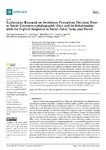Mostrar o rexistro simple do ítem
Exploratory Research on Sweetness Perception: Decision Trees to Study Electroencephalographic Data and Its Relationship with the Explicit Response to Sweet Odor, Taste, and Flavor
| dc.contributor.author | Romeo-Arroyo, Elena | |
| dc.contributor.author | Soria, Javier | |
| dc.contributor.author | Mora, María | |
| dc.contributor.author | Laport López, Francisco | |
| dc.contributor.author | Moreno-Fernandez-de-Leceta, Aitor | |
| dc.contributor.author | Vázquez-Araújo, Laura | |
| dc.date.accessioned | 2022-12-28T11:29:54Z | |
| dc.date.available | 2022-12-28T11:29:54Z | |
| dc.date.issued | 2022 | |
| dc.identifier.citation | Romeo-Arroyo, E.; Soria, J.; Mora, M.; Laport, F.; Moreno-Fernandez-de-Leceta, A.;Vázquez-Araújo, L. Exploratory Research on Sweetness Perception: Decision Trees to Study Electroencephalographic Data and Its Relationship with the Explicit Response to Sweet Odor, Taste, and Flavor. Sensors 2022, 22, 6787. https://doi.org/10.3390/s22186787 | es_ES |
| dc.identifier.issn | 1424-8220 | |
| dc.identifier.uri | http://hdl.handle.net/2183/32238 | |
| dc.description.abstract | Using implicit responses to determine consumers’ response to different stimuli is becoming a popular approach, but research is still needed to understand the outputs of the different technologies used to collect data. During the present research, electroencephalography (EEG) responses and self-reported liking and emotions were collected on different stimuli (odor, taste, flavor samples) to better understand sweetness perception. Artificial intelligence analytics were used to classify the implicit responses, identifying decision trees to discriminate the stimuli by activated sensory system (odor/taste/flavor) and by nature of the stimuli (‘sweet’ vs. ‘non-sweet’ odors; ‘sweet-taste’, ‘sweet-flavor’, and ‘non-sweet flavor’; and ‘sweet stimuli’ vs. ‘non-sweet stimuli’). Significant differences were found among self-reported-liking of the stimuli and the emotions elicited by the stimuli, but no clear relationship was identified between explicit and implicit data. The present research sums interesting data for the EEG-linked research as well as for EEG data analysis, although much is still unknown about how to properly exploit implicit measurement technologies and their data. | es_ES |
| dc.description.sponsorship | Diputación Foral de Guipúzcoa; 2019-GAST-000024 | es_ES |
| dc.description.sponsorship | Gobierno Vasco; 00051-IDA2020-43 | es_ES |
| dc.description.sponsorship | Xunta de Galicia; ED431G2019/01, ED481A-2018/156 | es_ES |
| dc.language.iso | eng | es_ES |
| dc.publisher | Multidisciplinary Digital Publishing Institute (MDPI) | es_ES |
| dc.relation.uri | https://doi.org/10.3390/s22186787 | es_ES |
| dc.rights | Atribución 3.0 España | es_ES |
| dc.rights | © 2022 by the authors. Licensee MDPI, Basel, Switzerland. This article is an open access article distributed under the terms and conditions of the Creative Commons Attribution (CC BY) license (https://creativecommons.org/licenses/by/4.0/ ). | es_ES |
| dc.rights.uri | http://creativecommons.org/licenses/by/3.0/es/ | * |
| dc.subject | EEG | es_ES |
| dc.subject | sucrose | es_ES |
| dc.subject | clustering algorithms | es_ES |
| dc.subject | Sensory modality discrimination | es_ES |
| dc.title | Exploratory Research on Sweetness Perception: Decision Trees to Study Electroencephalographic Data and Its Relationship with the Explicit Response to Sweet Odor, Taste, and Flavor | es_ES |
| dc.type | info:eu-repo/semantics/article | es_ES |
| dc.rights.access | info:eu-repo/semantics/openAccess | es_ES |
| UDC.journalTitle | Sensors | es_ES |
| UDC.volume | 22 | es_ES |
| UDC.issue | 18 | es_ES |
| UDC.startPage | 6787 | es_ES |
Ficheiros no ítem
Este ítem aparece na(s) seguinte(s) colección(s)
-
GI-GTEC - Artigos [190]






